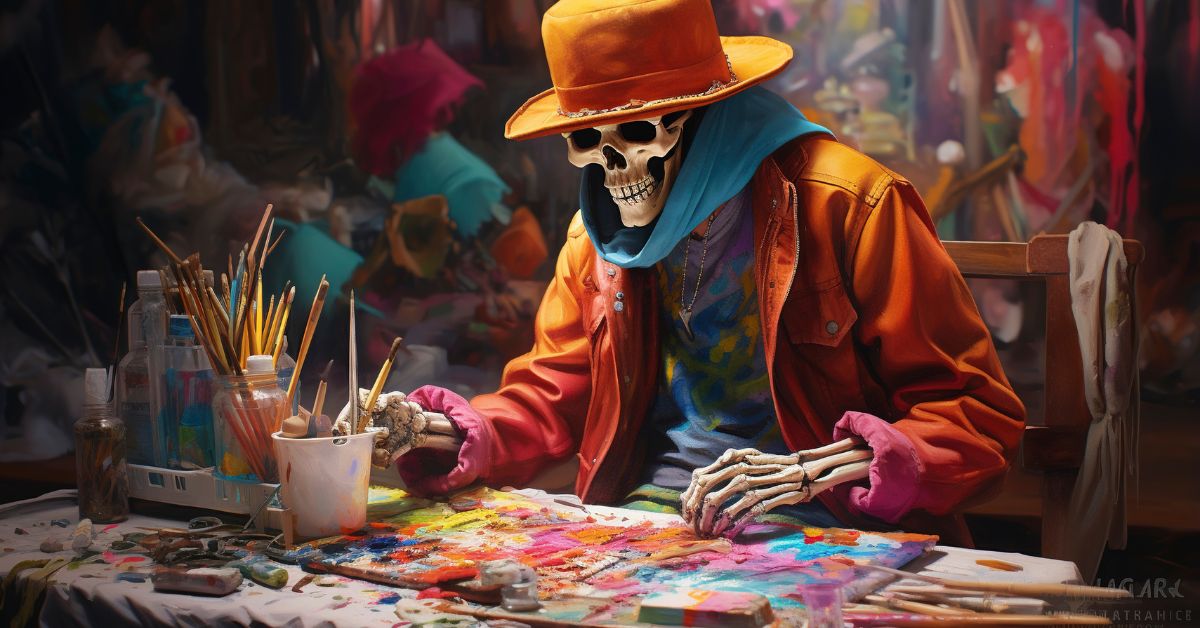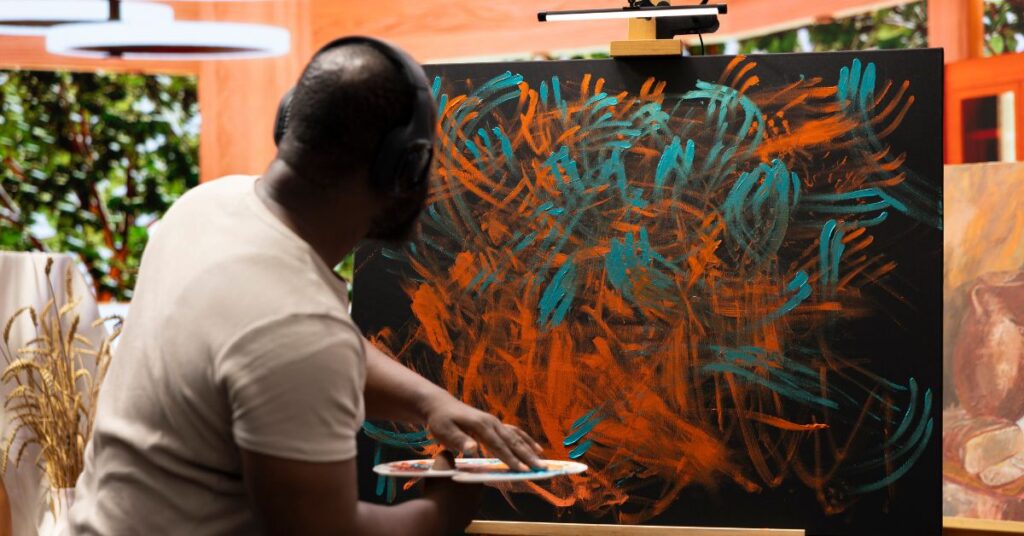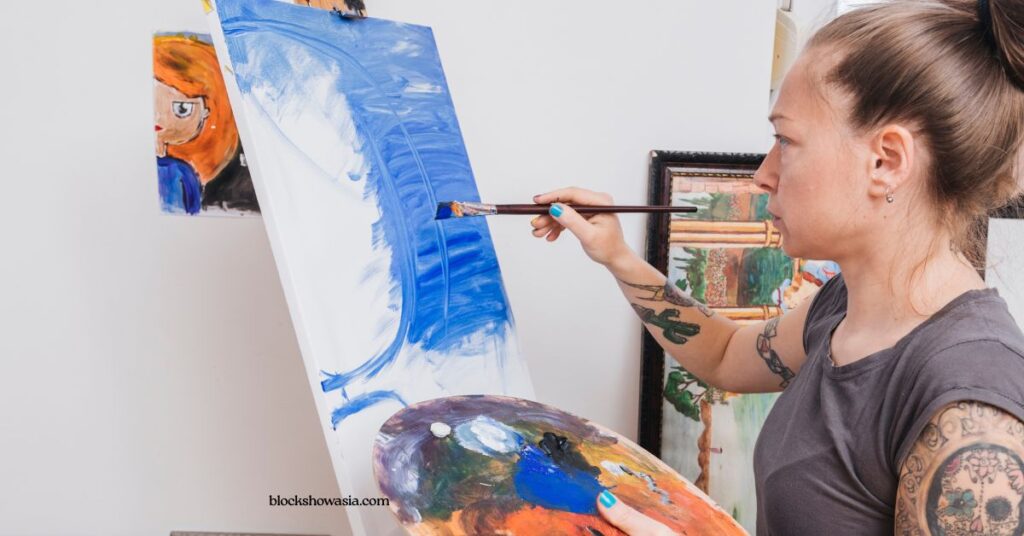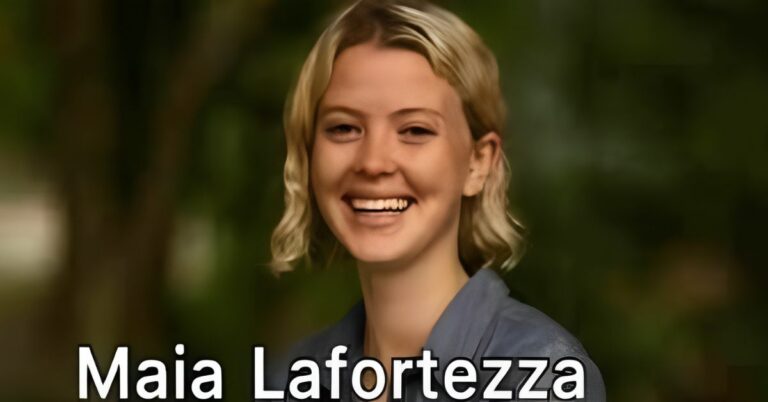What is Artofzio? A Creative Journey That Will Inspire You [2025 Guide]

Artofzio blends traditional art with digital breakthroughs to reshape creativity today. Artists, both seasoned professionals and newcomers, have embraced this fresh approach that spans from vivid digital canvases to complex mixed-media designs.
The platform stays true to artistic authenticity and leverages advanced technology through AI-assisted creation tools and digital collaboration spaces. Artists can express themselves freely with innovative tools and sell their work in a worldwide marketplace.
This piece analyses Artofzio’s progress, core beliefs, and how it affects artistic expression. The platform continues to mould art’s future and tackles key questions about keeping authenticity while integrating technology into creative work.
The Evolution of Artofzio: From Concept to Movement
Artofzio started with a vision that went beyond traditional art boundaries. The movement grew as a bold answer to artists who needed new ways to express themselves in our digital world.
The founding vision
A deep passion for art and storytelling sparked Artofzio’s creation. The founder wanted to build a space where artists could share their work and connect with people worldwide. This idea welcomed creators from all backgrounds to explore their artistic potential freely.
“The goal was to create a community that celebrates artistic expression and collaboration,” notes one of the movement’s early documents. The founders came from fine arts and digital design backgrounds. They blended classic methods with modern technology to connect traditional craft with fresh approaches.
Artofzio found its true identity when its creators started using AI in their work. This choice helped develop a unique style that mixed traditional art’s natural feel with AI-powered precision. The result stayed authentic while it controlled new technological possibilities.
Key milestones in development
Artofzio grew quickly from its humble start. Artists of all skill levels found a platform that valued their unique viewpoints. The community expanded faster than expected and turned from an idea into a thriving creative hub.
The first major Artofzio exhibit engaged audiences by changing how people interact with art installations. These exhibits encouraged active participation instead of passive viewing. Art became something people could experience rather than just observe.
The movement soon spread globally with shows in Singapore, New York, Dubai, and London. Artofzio kept evolving by adding environmental themes, advanced lighting, and immersive storytelling.
Partnerships became crucial milestones too. Working with schools helped inspire young artists, showing Artofzio’s commitment to future talent. Solar-powered installations proved the movement cared about both art and sustainability.
The philosophy behind the name
“Artofzio” combines “art” with a personal touch that highlights individual creativity. This word blend reflects how the movement mixes different concepts at its core.
Artofzio means more than just art—it represents ideas that challenge old rules and accept new ideas. It proves art should surpass strict guidelines and find balance between structure and spontaneity.
The movement then grew into an adaptable art form that works with many genres. It became a philosophy that encourages unlimited creativity by mixing painting, digital art, sculpture, and design.
Key artists like Lily-Tiger helped shape Artofzio’s foundation. She combined surrealism with digital precision in her work. Her detailed, thought-provoking pieces inspired others to challenge digital art’s limits.
Artofzio makes art more welcoming than traditional galleries, which often feel distant. It brings creativity into friendly spaces where people can enjoy and learn. The focus changed from just looking at art to experiencing it fully.
The Three Pillars of Artofzio Creation
Artofzio has grown beyond an artistic platform, built on three core elements. These pillars—digital craftsmanship, community collaboration, and technological innovation—support this creative movement’s ongoing rise and development.
Digital craftsmanship
Artofzio deeply commits to combining traditional artistic techniques with innovative digital tools. This blend creates perfect harmony between past and future. Artists can now create unique works that traditional methods alone couldn’t achieve.
Digital craftsmanship at Artofzio includes testing new materials, tools, and techniques. Artists start with basic skills on simple tablets that become their digital canvases. They gradually develop advanced methods and add vibrant colours and complex patterns that engage viewers.
“Artofzio blends artistic vision with cutting-edge digital tools to unlock new possibilities for self-expression,” notes one source. Creators can now combine analogue and digital worlds naturally. The workshops let participants learn hands-on with graphic tablets, 3D modelling software, and augmented reality design techniques to build their skills.

Technological innovation
Technological innovation, the third pillar, drives Artofzio into new creative territories. The platform keeps redefining artistic creation by adding innovative technologies to the art-making process.
Artofzio welcomes advanced technological tools including:
- Augmented Reality (AR) Studios: Create immersive artworks in three-dimensional space
- AI-Powered Assistants: Automate routine tasks to focus more on creativity
- Virtual Reality (VR) Showcases: Present art interactively to engage audiences in new ways
“Artofzio embraces this integration, offering tools that blend AI’s potential with traditional creative techniques,” states one source. Human creativity meets technological capability to enable previously unimaginable artistic expressions.
Artofzio also explores ways to create fully immersive artistic experiences. Audiences can now interact with art in entirely new dimensions. These breakthroughs make art more available while expanding creative boundaries.
The technological innovation pillar keeps Artofzio pioneering artistic development. The platform encourages artists to test conventional boundaries and find fresh approaches to creative expression through new techniques, styles, and tools.
How Artofzio is Reshaping Traditional Art Forms
Artofzio challenges the boundaries between traditional and digital art creation. Their innovative approach doesn’t just replace old methods. Instead, it boosts them through smart use of technology that opens up new possibilities for artistic expression.
Blending physical and digital techniques
Artofzio shines at combining physical and digital techniques to create hybrid art forms that showcase the best of both worlds. Artists start with traditional materials and add digital elements to expand their creative range. This experimental approach lets them make endless changes, add complex layers, and refine details that would be hard to achieve with physical methods alone.
“Unlike physical canvases, digital platforms allowed for endless revisions, layering techniques, and intricate detailing,” says someone who follows the movement. Artists use this unique method to add depth to their work and build artistic identities that grow over time.
The biggest advantage lies in how easy it is to access. Traditional art needs physical space and materials. But Artofzio artists can work from anywhere. They keep creating while reaching audiences worldwide. This flexibility has made art more democratic and helps creators who might face location or resource limits.
Reimagining painting and sculpture
Artofzio changes how artists think about painting and sculpture. Digital artists in this movement use tech to create vibrant visuals. Their work keeps the emotional punch of traditional painting while adding new interactive layers and depth.
“With vibrant colours and intricate designs, ArtofZio fascinates audiences on platforms of all types,” notes a source learning about this rise. Artists mix different media to give their work richer textures and visual complexity. Pop art mixes with abstract designs to create dynamic fusions that speak to many different viewers.
Artofzio has brought revolutionary methods to sculpture that take three-dimensional art into the digital age. Artists make complex 3D models on computers and print them as physical sculptures. This pushes traditional sculpting’s limits. The process creates intricate forms that would be nearly impossible to make by hand.
Interactive installations that respond to viewer input blur the line between physical and virtual worlds. These pieces change how we think about sculpture. They turn passive viewing into active participation.
Artofzio AI: The New Frontier of Creative Assistance
Artofzio AI stands as a game-changing force in digital art’s ever-changing world. It boosts creative processes and brings up key questions about artistic expression’s future. This tech doesn’t just automate creation – it changes how artists think up, develop, and polish their work.
Understanding AI-assisted creation
Artofzio AI works as your creative partner instead of replacing human creativity. Studies show AI help increases creative output by 25% and doubles the chances of getting good feedback. These gains come from AI’s power to analyse huge data sets, spot patterns, and create original content from simple prompts.
Artists and AI form what experts call “generative synaesthesia” – a perfect blend of human exploration and AI capabilities to find new creative ways of working. Artists bring ideas and judgement while AI handles technical work and variations.
Artofzio AI helps in every part of making art:
- Conceptual development: Creates unexpected combinations that inspire
- Technical execution: Handles routine tasks so you can focus on being creative
- Refinement: Gives live suggestions and different approaches
Research shows people who think outside the box create better AI-assisted artwork. This proves human creativity drives everything, and AI just makes it stronger rather than being the source.
Ethical considerations
Artofzio’s deeper AI integration brings ethical challenges. The biggest problem is ownership – who owns the art when someone types prompts into an AI system others programmed?
AI systems also risk copying human bias because they learn from existing data. One expert says “AI not only replicates human biases, it confers on these biases a kind of scientific credibility”. This raises fairness issues in AI-assisted creation.
There’s another reason to worry – authenticity. Studies show people see AI-assisted art as less authentic and easier to make, even though it’s more innovative. This gap shows how complex the relationship between tech help and art’s value really is.
Artofzio follows principles like those the Alan Turing Institute supports:
- Fairness: Stops bias in creative outputs
- Accountability: Shows how AI tools shape creation
- Sustainability: Keeps AI systems safe and reliable
- Transparency: Explains AI models’ decisions in context

Future developments in creative AI
Artofzio keeps improving its AI abilities in exciting ways. About 80% of creators want AI to handle boring tasks so they can focus on creative work, but the tech can do much more.
New features will fit better into creative software and give live help that matches your way of working. But experts warn about long-term effects, saying “widespread use of generative AI in creative fields could lead to many works looking too similar”.
To stop this sameness, Artofzio heads over to new ways to make AI systems boost originality. They’re building models that learn from different kinds of data and encourage exploration over repetition.
The best artists in this new age will be those who balance state-of-the-art tech with real human expression. They’ll use AI to explore rather than letting it lead their creative direction.
The Global Impact of the Artofzio Movement
Artofzio has redefined artistic methods and left its mark on global cultures, educational systems, and economic landscapes. This creative movement continues to grow internationally and changes how people see, teach, and monetize art worldwide.
Cultural influences across continents
Artofzio breaks geographical boundaries and creates an array of diverse artistic expressions that strike a chord across continents. Research shows emotional reactions to art and aesthetic judgments vary substantially between cultures. To name just one example, studies show different cultures categorise facial expressions with varying intensity levels of positive affect differently.
Traditional Western art often highlights the object itself, while East Asian artistic approaches focus more on contextual elements. Artofzio welcomes these differences and celebrates how various cultures interpret visual elements differently instead of forcing a single aesthetic standard.
The platform has created a global language of creativity that respects cultural nuances while promoting cross-cultural understanding. Islamic art’s intricate calligraphy and African traditions’ vibrant patterns find their place on Artofzio’s digital canvas, where these diverse expressions inspire one another.
Educational transformation
Artofzio has transformed art education with its innovative approach to mentorship and skill development. The platform’s mentorship programmes help aspiring artists become skilled at digital tools. Artists can access artistic knowledge whatever their location or formal educational background.
Workshops and online tutorials equip emerging talents with practical skills and nurture their creative potential. This educational approach goes beyond technical training to include collaborative learning environments where artists share techniques and offer constructive feedback.
Economic opportunities for creators
Artofzio has created unprecedented economic opportunities for artists worldwide. The creator economy market currently stands at £198.54 billion and experts expect it to double by 2027. Artists on Artofzio have developed innovative strategies to build sustainable careers:
- NFT marketplaces: Artofzio artists use blockchain technology to sell digital art securely and transparently
- Licencing and collaborations: Many creators earn revenue through partnerships with brands and creative agencies
- Direct-to-consumer sales: Artists showcase their work to millions of digital art collectors and enthusiasts globally
The platform helps creators from underrepresented communities by removing traditional gatekeepers. Recent research shows YouTube’s creative ecosystem alone contributed over €5.5 billion to the EU27’s GDP and supported more than 150,000 full-time equivalent jobs in 2022. Artofzio creates similar economic value by connecting artists directly with their audiences.
Challenges and Criticisms of the Artofzio Approach
Artofzio’s fresh approach and rising popularity come with several substantial challenges that need careful examination. This creative movement blends technology with traditional art forms and must deal with complex issues about access, authenticity, and the true nature of artistic expression.
Accessibility concerns
The artistic world still grapples with accessibility issues. Studies show that 96.3% of internet home pages don’t meet all accessibility guidelines. Digital art platforms might remain out of reach for people with visual, auditory, motor, speech, or cognitive disabilities.
Artofzio’s heavy dependence on advanced technology creates similar barriers. Critics point out that the platform might unintentionally leave out artists who don’t have sophisticated equipment or stable internet connections.
Cultural organisations are “distressingly unprepared to work with disabled individuals”, according to disability supporters. Artofzio’s growth demands more than just following guidelines. The platform needs inclusive design principles to make art truly available to everyone.
Questions of authenticity
The debate about Artofzio’s authenticity mainly focuses on AI-generated content. “Critics argue that the heavy reliance on digital tools makes art less personal and more mechanical”. This reflects a wider issue within digital art communities.
Forgery takes on new meaning in Artofzio’s world. Traditional forgery meant lying about how art was made. Now, with algorithms playing a big role in creation, people ask who really made the art and how original it is. Research reveals that people see AI-assisted content as less authentic but more innovative.
Balancing technology and human expression
Artofzio artists face a big challenge: finding the right balance between using technology and keeping their own creative touch. Studies show that if we rely too much on technology, we risk losing something people still really care about — real human connection.
The key to success is teamwork between humans and AI. AI can do the heavy data work, while people focus on ideas and building real relationships. In fact, over 57% of brands say that having humans guide AI helps get the best results.
The most successful Artofzio artists see AI as a helper, not a replacement. They understand that human traits like empathy, cultural understanding, and deep emotions are still very important. These human qualities make art feel real and meaningful — even in a high-tech world.
Conclusion
Artofzio shows how art is growing by mixing traditional creativity with modern digital tools. Even though there are challenges like access and staying true to real art, artists around the world are finding new ways to express themselves.
Artofzio’s technology doesn’t take away from human creativity—instead, it helps artists do even more with their ideas. Those who use both old and new methods are joining a strong and growing global art community. Their work reflects different cultures while using the latest digital tools.
The success of the Artofzio community proves that art and technology can work well together. These artists create meaningful, modern art while still keeping it real and human. This shows that true creativity can grow without losing its original spirit.
FAQs
1. What is Artofzio and how does it differ from traditional art forms?
Artofzio is an innovative creative movement that blends traditional artistry with digital technology. It uses AI-assisted tools and digital platforms to create unique artworks, fostering a global community of artists who collaborate and share their creations across various mediums.
2. How does Artofzio impact an artist’s creative journey?
Artofzio enhances an artist’s creative journey by providing digital tools and AI assistance that expand artistic possibilities. It encourages experimentation, allows for endless revisions, and facilitates collaboration with artists worldwide, inspiring new forms of expression and pushing creative boundaries.
3. What are the main pillars of Artofzio creation?
The three main pillars of Artofzio creation are digital craftsmanship, community collaboration, and technological innovation. These elements work together to provide artists with cutting-edge tools, a supportive global network, and opportunities to explore new artistic frontiers.
4. How does Artofzio address concerns about authenticity in AI-assisted art?
Artofzio recognises the importance of maintaining human creativity at the core of artistic expression. While AI tools are used to enhance and streamline the creative process, the platform emphasises that human input, emotion, and decision-making remain central to creating authentic and meaningful art.
5. What economic opportunities does Artofzio offer to artists?
Artofzio provides artists with various economic opportunities in the growing creator economy. These include selling digital art through NFT marketplaces, licencing artwork for collaborations with brands, and reaching global audiences through direct-to-consumer sales platforms, enabling artists to monetise their work more effectively.






